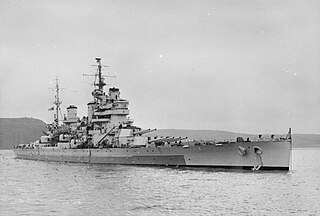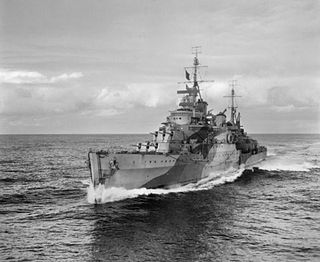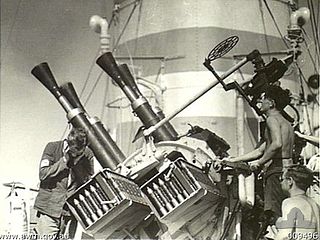
"Pom-Pom" director was a director for British anti-aircraft guns on British warships of the 1930s into the Second World War.

"Pom-Pom" director was a director for British anti-aircraft guns on British warships of the 1930s into the Second World War.
The Vickers 40 mm QF 2 pounder "Pom-Pom" gun anti-aircraft mounting was introduced to the Royal Navy in the early 1930s. The multi-barrel mounting was capable of a tremendous volume of fire but the crew had great difficulty in aiming the mounting due to the smoke and vibration created by the guns. It was, therefore, essential to aim the mount from a remote location, using a director that had a clear view, free from smoke and vibration. The director crew would aim at the target aircraft and, in the early versions of the director, cause the layer (altitude) and trainer (azimuth) pointers to rotate on the gun mount. The gun crew would then move the mount to match the pointers rather than having to try and aim at the target aircraft.
Directors I to III controlled the gun mounting through "follow the pointer" control and aimed at aircraft using eye shooting techniques through a simple ring sight. [1] These directors began to appear on Royal Navy cruisers, battleships and aircraft carriers in 1930. They were universally fitted, one per pom-pom gun mounting, by the late 1930s. [2] Most destroyers and smaller ships that carried 2-pounder guns continued to rely on aiming the guns with the on-mount gunsights due to the lack of space on these ships to site a director. [3]
The Mk IV director was a considerable improvement and used gyroscopes in a gyro rate unit coupled to an optical rangefinder and Type 282 radar to determine the range, speed and direction of enemy aircraft and then used an on-director computer to produce an accurate fire control solution to hit the target. Later versions of the Mk IV director introduced remote power control (RPC) and could control the gun mounting by remote control from the director. [4] The Mk IV director was fully tachymetric, but performance suffered as the director was not stabilized against the movement of the ship. It consequently required a carefully trained crew (a total of eight including the radar operator in the radar office) to achieve good results. [5] Even so, the Mk IV director was highly advanced and placed the Royal Navy in the forefront of naval anti-aircraft fire control [6] when it was introduced to the Royal Navy on HMS King George V in 1940. [7] Later versions were upgraded with Type 282 radar and RPC beginning in 1941, with HMS Prince of Wales being one of the first ships to receive the radar upgrade, which she first used in action during Operation Halberd. [8]
![]() Media related to QF 2 pounder pom-pom at Wikimedia Commons
Media related to QF 2 pounder pom-pom at Wikimedia Commons

The Revenge class, sometimes referred to as the Royal Sovereign class or the R class, consisted of five superdreadnought battleships built for the Royal Navy in the 1910s. All of the ships were completed to see service during the First World War. There were originally to have been eight of the class, but two were later redesigned, becoming the Renown-class battlecruisers, while the other, which was to have been named HMS Resistance, was cancelled outright. The design was based on that of the preceding Queen Elizabeth class, but with reductions in size and speed to make them more economical to build.

The Fiji-class cruisers were a class of eleven light cruisers of the Royal Navy that saw extensive service throughout the Second World War. Each ship of the class was named after a Crown colony or other constituent territory of the British Commonwealth and Empire. The class was also known as the Colony class, or Crown Colony class. Developed as more compact versions of the preceding Town-class cruisers, the last three were built to a slightly modified design and were sometimes also called the Ceylon class.

HMS King George V was the lead ship of the five British King George V-class battleships of the Royal Navy. Laid down in 1937 and commissioned in 1940, King George V operated during the Second World War in all three major theatres of war, the Atlantic, Mediterranean and Pacific, as well as part of the British Home Fleet and Pacific Fleets. In May 1941, along with HMS Rodney, King George V was involved in the hunt for and pursuit of the German battleship Bismarck, eventually inflicting severe damage which led to the German vessel's sinking. On 1 May 1942 the destroyer HMS Punjabi sank after a collision with King George V in foggy conditions. King George V took part in Operation Husky and bombarded the island of Levanzo and the port of Trapani. She also escorted part of the surrendered Italian Fleet, which included the battleships Andrea Doria and Duilio, to Malta. In 1945 King George V took part in operations against the Japanese in the Pacific.

HMS Anson was a King George V-class battleship of the Royal Navy, named after Admiral George Anson. She was built by Swan Hunter and Wigham Richardson Shipyard and launched on 24 February 1940, being completed on 22 June 1942. Her completion was delayed to allow the fitting of fire-control radar and additional anti-aircraft weapons. She was originally to have been named Jellicoe, but was renamed Anson in February 1940.

HMS Revenge was the lead ship of five Revenge-class super-dreadnought battleships built for the Royal Navy during the First World War in the mid-1910s. The ships were developments of the Queen Elizabeth-class battleships, with reductions in size and speed to offset increases in armour protection whilst retaining the same main battery of eight 15-inch (381 mm) guns. She was laid down in 1913, launched in 1915 and commissioned in February 1916, early enough to be worked up to see action with the Grand Fleet at the Battle of Jutland in May that year. During the engagement, she engaged German battlecruisers, damaging two of them before being forced to turn away to avoid torpedoes that damaged her squadron flagship and caused the squadron to lose contact with the rest of the fleet. Revenge emerged from the battle unscathed, but she saw no further action during the war, as the British and German fleets turned to more cautious strategies owing to the risk of submarines and naval mines.

HMS Royal Sovereign was a Revenge-class battleship of the Royal Navy displacing 29,970 long tons (30,450 t) and armed with eight 15-inch (381 mm) guns in four twin-gun turrets. She was laid down in January 1914 and launched in April 1915; she was completed in May 1916, but was not ready for service in time to participate in the Battle of Jutland at the end of the month. She served with the Grand Fleet for the remainder of the First World War, but did not see action. In the early 1930s, she was assigned to the Mediterranean Fleet and based in Malta.

The Town class consisted of 10 light cruisers built for the Royal Navy during the 1930s. The Towns were designed to the constraints imposed by the London Naval Treaty of 1930. The ships were built in three distinct sub-classes, the Southampton, Gloucester and Edinburgh classes respectively, each sub-class adding on further weaponry.

The Dido class consisted of sixteen light cruisers built for the Royal Navy during World War II. The first group of three ships were commissioned in 1940, the second group and third group were commissioned between 1941 and 1942. A fourth group, also described as the Improved Dido, or the Bellona class, were commissioned between 1943 and 1944. Most members of the class were given names drawn from classical history and legend. The groups differed in armament, and, for the Bellonas, in function. The Dido class were designed as small trade protection cruisers, and were designed with five turrets, each with twin 5.25 guns in high angle mountings, far more modern in design than previous light cruiser turrets, and offering efficient loading up to 90 degrees elevation to give some dual-purpose capability. While some damage was experienced initially in extreme North Atlantic conditions, modified handling avoided the problem. The fitting of the three turrets forward in A, B and C position depended on some use of aluminium in the structure and the lack of aluminium after Dunkirk was one of the reasons for only four turrets being fitted to the first group of three, while the third group had four turrets with twin 4.5 guns. The Bellona's were designed from the outset with four turrets, but with radar-guided guns, and carried an increased light anti-aircraft armament.

HMS Nelson was the name ship of her class of two battleships built for the Royal Navy in the 1920s. They were the first battleships built to meet the limitations of the Washington Naval Treaty of 1922. Entering service in 1927, the ship spent her peacetime career with the Atlantic and Home Fleets, usually as the fleet flagship. During the early stages of World War II, she searched for German commerce raiders, missed participating in the Norwegian Campaign after she was badly damaged by a mine in late 1939, and escorted convoys in the Atlantic Ocean.

The QF 4.5 inch gun has been the standard medium-calibre naval gun used by the Royal Navy as a medium-range weapon capable of use against surface, aircraft and shore bombardment targets since 1938. This article covers the early 45-calibre family of guns up to the 1970s. For the later unrelated 55-calibre Royal Navy gun, see 4.5 inch Mark 8 naval gun.

The L and M class was a class of sixteen destroyers which served in the British Royal Navy during World War II. The ships of the class were launched between 1939 and 1942.

The C class was a class of 32 destroyers of the Royal Navy that were launched from 1943 to 1945. The class was built in four flotillas of 8 vessels, the "Ca", "Ch", "Co" and "Cr" groups or sub-classes, ordered as the 11th, 12th, 13th and 14th Emergency Flotillas respectively. The sub-class names are derived from the initial 2 letters of the member ships' names, although the "Ca" class were originally ordered with a heterogeneous mix of traditional destroyer names. A fifth flotilla, the "Ce" or 15th Emergency Flotilla, was planned but were cancelled in favour of the Weapon-class destroyers after only the first two ships had been ordered. The pennant numbers were all altered from "R" superior to "D" superior at the close of World War II; this involved some renumbering to avoid duplications.

A fire-control system is a number of components working together, usually a gun data computer, a director, and radar, which is designed to assist a ranged weapon system in targeting, tracking and hitting its target. It performs the same task as a human gunner firing a weapon, but attempts to do so faster and more accurately.

The 2-pounder gun, officially designated the QF 2-pounder and universally known as the pom-pom, was a 40-millimetre (1.6 in) British autocannon, used as an anti-aircraft gun by the Royal Navy. The name came from the sound that the original models make when firing. This QF 2-pounder was not the same gun as the Ordnance QF 2-pounder, used by the British Army as an anti-tank gun and a tank gun, although they both fired 2-pound (0.91 kg), 40-millimetre (1.6 in) projectiles.

The Lion class was a class of six fast battleships designed for the Royal Navy (RN) in the late 1930s. They were a larger, improved version of the preceding King George V class, with 16-inch (406 mm) guns. Only two ships were laid down before the Second World War began in September 1939 and a third was ordered during the war, but their construction was suspended shortly afterwards. The design was modified in light of war experience in 1942, but the two ships already begun were scrapped later in the year.

High Angle Control System (HACS) was a British anti-aircraft fire-control system employed by the Royal Navy from 1931 onwards and used widely during World War II. HACS calculated the necessary deflection required to place an explosive shell in the location of a target flying at a known height, bearing and speed.

Rangekeepers were electromechanical fire control computers used primarily during the early part of the 20th century. They were sophisticated analog computers whose development reached its zenith following World War II, specifically the Computer Mk 47 in the Mk 68 Gun Fire Control system. During World War II, rangekeepers directed gunfire on land, sea, and in the air. While rangekeepers were widely deployed, the most sophisticated rangekeepers were mounted on warships to direct the fire of long-range guns.

The Iowa-class battleships are the most heavily armed gunships the United States Navy has ever put to sea, due to the continual development of their onboard weaponry. The first Iowa-class ship was laid down in June 1940; in their World War II configuration, each of the Iowa-class battleships had a main battery of 16-inch (406 mm) guns that could hit targets nearly 20 statute miles (32 km) away with a variety of artillery shells designed for anti-ship or bombardment work. The secondary battery of 5-inch (127 mm) guns could hit targets nearly 9 statute miles (14 km) away with solid projectiles or proximity fuzed shells, and was effective in an anti-aircraft role as well. Each of the four battleships carried a wide array of 20 mm and 40 mm anti-aircraft guns for defense against enemy aircraft.

Ship gun fire-control systems (GFCS) are analogue fire-control systems that were used aboard naval warships prior to modern electronic computerized systems, to control targeting of guns against surface ships, aircraft, and shore targets, with either optical or radar sighting. Most US ships that are destroyers or larger employed gun fire-control systems for 5-inch (127 mm) and larger guns, up to battleships, such as Iowa class.
Gyro rate unit refers to a fire-control computer developed by the Royal Navy of the United Kingdom in 1937, and which was used extensively on British warships in World War II. In the 1930s the Royal Navy began to investigate the possibility of combining gyroscopes with optical sights to directly and accurately measure target aircraft speed and direction and began development of the GRU in 1937. A gyroscope was attached, via mechanical linkage, to an optical monocular sight to form the gyro rate unit or GRU.